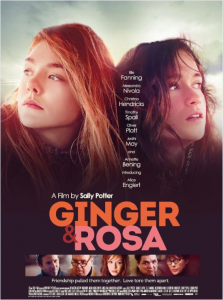feminist film history 101: ginger & rosa
In this series, Lip writers take a look at a wide range of films to determine what it is that makes a great feminist film. From the black-and-white classics right up to the newest of new releases, this retrospective examines just what’s in the feminist film canon — and asks if anything needs to be added to it. Michael Wu takes a look at a potentially-overlooked modern classic, the coming-of-age tale Ginger & Rosa.
Sally Potter’s Ginger & Rosa is a film about growing up. While it would be easy for Potter to make a film on this topic, perfunctorily earning its “coming of age” label by giving it a cloying pseudo-folksy soundtrack and an expertly choreographed and perfectly thematic sex scene, Potter’s film is smarter than this. It strives for something honest and realistic about the time in a person’s life when they crave change but don’t yet know how to accomplish it.
The film stars Elle Fanning as Ginger, a teenage girl in 1960s London, and her best friend, Rosa, played by Alice Englert. Potter’s film highlights the rising international tensions as the Cuban Missile Crisis began to define the time period; the opening scene is that of a detonating atomic bomb. The Crisis looms over the heads of every character, especially Ginger. She becomes increasingly anxious as the film goes on, dragging Rosa to “Ban the Bomb” meetings and demonstrations.
Under the threat of destruction, Ginger’s activism is met with a mixed response. Her father, Roland (Alessandro Nivola) and fellow activist Bella (Annette Benning) excitedly approve of her stance while her mother Natalie (Christina Hendricks) encourages her to not involve herself in the conflict, and even encourages her to take ‘domestic sciences lessons’ at her school.
What allows Ginger to truly develop into something more interesting than a “rebellious” teenager is Potter’s understanding of her protagonist, and the way in which she takes all of Ginger’s fears and anxieties seriously. Seventeen-year-old Ginger, like many others her age, is no longer seeing the world through the eyes of a child, but is beginning to understand her surroundings and all their violence and ugliness. Fanning, who was thirteen when she made this film, perfectly captures this throughout the film. She is wide-eyed and curious, expertly embodying the anxiety of youth on the brink of disillusionment in her performance.
The international crisis provides a dramatic stage for Ginger’s first taste of adulthood, and Potter keeps in mind the changing social dynamics of the period. During the film’s first half hour or so, Ginger and Rosa are almost inseparable, doing even the most mundane of activities together, including straightening their hair with a clothing iron or shrinking pairs of jeans in a tub. The girls begin growing apart, however, as Rosa becomes increasingly curious about her own sexuality. She goes further with boys than Ginger does; she begins wearing makeup and stealing Ginger’s mother’s clothing. Eventually, she engages in an ill-advised affair with a man that causes serious tension between the girls and threatens to completely destroy their friendship, which leads to scenes that are unfortunately melodramatic and heavy-handed, a betrayal to the restrained and intimate tone the film had already established.
The story of Rosa’s sexual awakening is not nearly as well developed as Ginger’s political coming of age, partly because Ginger ultimately becomes the film’s lead, but the two do prove complementary to each other thematically. Both place the characters in situations that underscore the restlessness, inquisitiveness and the desire for change that come to define adolescence. Both allow Potter to examine society at the time, which was radically shifting, especially in the eyes of youth. While attitudes were quickly changing, the staunch conservatism of the 1950s still had a hold of a portion of society. Ginger’s and Rosa’s rebellions against these traditional ideals allow Potter to highlight these changing roles, not just for teenagers, but for women as well.
The film’s colour scheme mostly consists of drab greys, blacks and browns. It’s not the most appealing visually, but does feel appropriate when set against the constraints of a cold war. However, standing against all this is Ginger, whose fiery red hair feels almost like a symbol of rebellion. She does not want to live in a world that is dominated by fear, and is determined to find her own voice, and to live long enough for it to be heard.
While some of it digresses into melodrama, the film succeeds because its director respects her protagonist, and the actress portraying her has an infectiously natural confidence. Potter understands the uncertainties of being on the brink of adulthood, attempting to find a role in a rapidly evolving society. In the capable hands of Potter and Fanning, Ginger & Rosa is one of the most realistic and intelligent coming of age films in years.



Wow, Michael, this is profound! “I am woman, hear me roar!”, every young woman should be exposed to this.
Hi Michael,
This is a fantastic review unheard of for sometime. To those fans and admirers of the English language, your review is a canvas of exquisite
beauty and clarity of imagination.